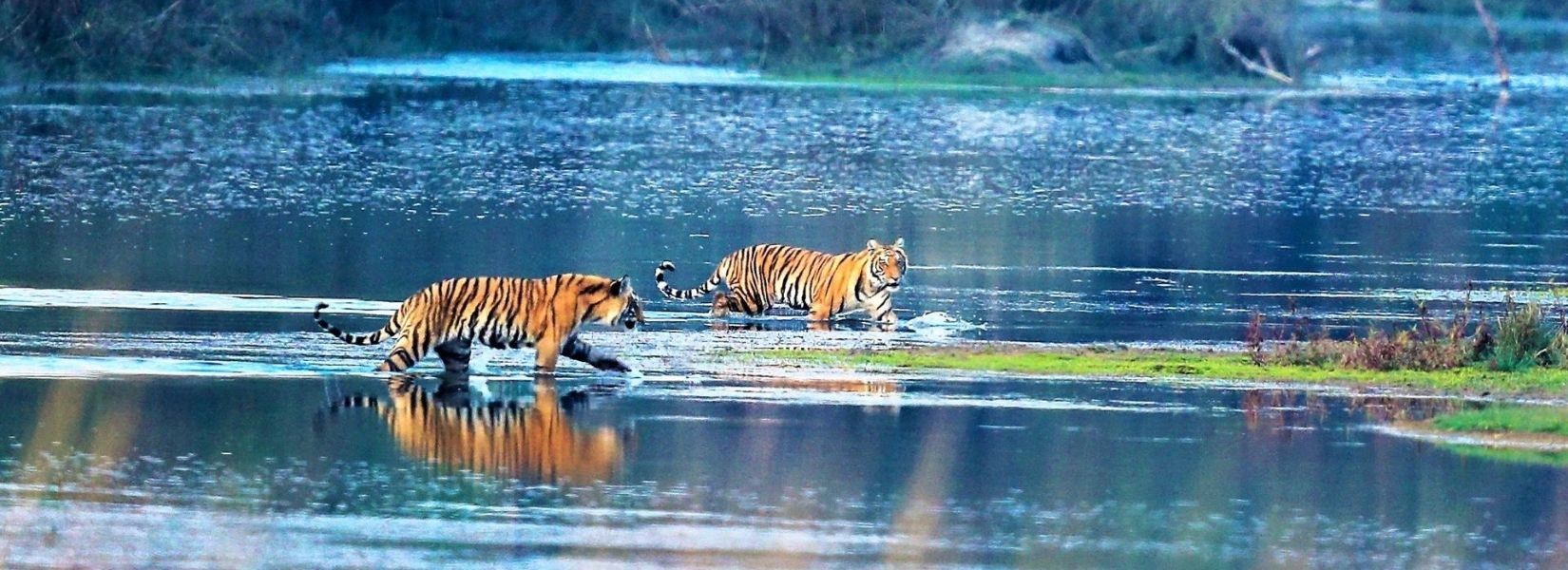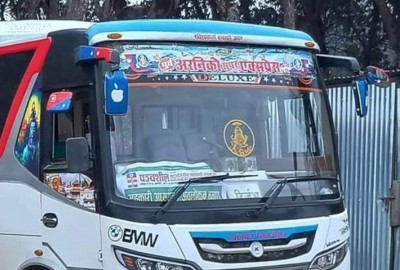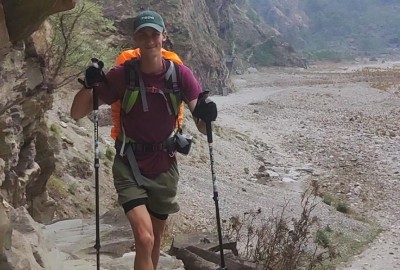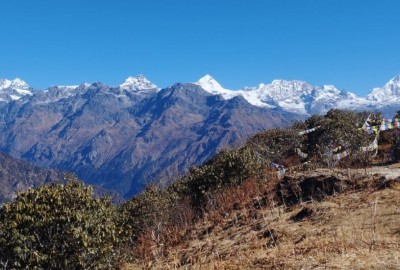Bardia National Park, established in 1988, is a protected area in Nepal which covers an area of 374 sq. mi. (968 km²). It is the largest and unruffled wilderness area which adjoins in the Bardiya District to the eastern bank of the Karnali River.
Table of Contents
Plan your trip to Nepal
Customize your trip with help from a local travel specialist.
The crest of the Siwalik Hills marks off the protected area's northern limits. While the southern boundary is partially formed by the Nepalgunj-Surkhet highway, it vigorously agitates the protected area. In the west, a branch of the Karnali River called the Geruwa and the Babai River in the Southeast are natural boundaries to human settlements. The coherent protected area of 1,437 km2 (555 sq mi) including the neighboring Banke National Park which serves as the Tiger Conservation Unit (TCU). Subtropical moist forest and alluvial grasslands are mostly what extends over 2,231 km² of Bardia and Banke.
In the largest national park in Nepal, you can ride through the serene Bardia jungle and see various wild animals. With experienced naturalists, you can take nature walks through the jungle. You can watch the Gangetic dolphins surface or gharials lazing around in the sun in the longest river in Nepal, Karnali if you go for white water rafting.
A few hours by road and a one hour flight from Kathmandu brings you to the west side of Nepal where Bardiya is. The jungle safaris are an exceptional feat of Bardia National Park and the sights countless species of birds, reptiles and mammals will stay as memories with you for life. While Chitwan has most of the animals they have here, animals like Bluebell are only found in Bardiya.
Home to the endangered Royal Bengal Tiger and the One-horned rhinoceros among other animals, Bardia National Park is one of the most wholesome conservation areas in Terai. The Babai river flows right through the park as the Churia range borders in the north. The park is situated in the far western district of Bardiya.
The national park is an ideal habitat for animals of all kinds to roam freely as it is covered in vast Sal and riverine forests and tall elephant grass. More than 250 species of birds, 30 species of mammals and several varieties of reptiles are hosted by the park. Tigers are sighted here more often than in any other national park. Hence, more tourists are attracted here to view the tiger. Other animals that can be seen here are the swamp deers, gharials, elephants, blackbuck, and marsh-muggers. If you're lucky, you might catch a glimpse of the exquisite Gangetic dolphin along the surface of Karnali. Silver-eared mesia, Bengal florican, sarus crane, and the lesser florican are some of the endangered birds that can be seen here.
Sportfishing is offered by the park in the Karnali and Babai rivers. Autumn, winter and early summer is the best time to visit the park as the weather is moderate during that time.
Things To Do in Bardia National Park
The activities that can be done in Bardia National Park are limited to wildlife and jungle exploration, unlike Chitwan National Park. National park tickets and guides are mandatory here. Bardiya does not offer commercial safari-style park, it rather offers an untamed jungle experience. Hence the chance of seeing a Royal Bengal Tiger is more than in any other national park in Nepal.
Jungle Walk
You have the option to choose the number of days you want this to last. They offer half-day, full-day, two or three days and one week. Private jungle trips are also available. A guide has to be present whether you choose to go alone or in a group. Meals are usually included in the cost. Rs 3,000 is the starting price for a half-day tour while a full-day tour is Rs 4000 for a person. The expected price for 4 people is around 3,500 rupees which can be divided among the group. The rates depend on the season, so you should look around.
While on the half-day tours, you'll most likely only end up seeing the jungle, you might see a rhino bathing if you're lucky. A half-day trip is not recommended as you will not get much of an experience. The chances of seeing rhinos, birds, wild elephants, other wildlife and even a tiger is significantly greater on a full day trip. As overnight trips go deeper into the forest, the chances of seeing a rhino are rather good.
Jeep Tour
For those who are in a hurry to go deeper into the jungle without walking, the jeep tour is perfect for them. The chances of seeing a tiger are greater in the jeep tour. The jeep tour is often included in packages and day trek excursions. The prices include accommodation and food and are usually USD $170 per day. The two or three days packages are better in value than one day ones. You should book in person than on the internet as the prices are often expensive online.
Elephant Ride
While elephant treks are offered in Bardiya, nowadays it is being discouraged and is also hard to find. The resorts are the ones who offer this and the trip is not worth the money. The trip usually lasts 1 to 1.5 hours and does a little exploration of the jungle. They are also much more expensive in comparison to Chitwan as the elephants in Chitwan are used by park rangers to help patrol the area. A national park ticket is required for all jungle treks.
Elephant Breeding Center
The elephant breeding center of Bardia is located on the edge of the national park and is small in comparison to Chitwan National Park's breeding center. The center is also not as educational as the one in Chitwan. You can find a variety of elephants in the center. Some are sick and old while some are injured. There are also newborn elephants and elephants which help to patrol the park. The entrance fee for a foreigner is Rs 50 while SAARC countries have to pay Rs 25. The locals and other Nepalese have to pay 10 rupees. The center is open from 10 am to 6 pm. It is recommended to go as early as possible so you can see all the elephants as some have to leave for park patrol.
Crocodile Breeding center
The crocodile breeding center of Bardia is located near the entrance of Bardia National Park. You might want to skip this if you've already seen the wild Gharial crocodiles or marsh muggers. It does not take long to visit this center.
Tharu Museum
A small museum dedicated to the Tharu community is next to the crocodile breeding center. As soon as you enter this, you will see various indigenous artifacts that range from farming tools to kitchen wares as well as some signboards with Tharu history. The cost to enter the museum is 50 rupees. It is a little baffling that the cost for the museum and breeding center is not included in the ticket. But if you have never seen a Tharu village now is your chance.
Another way to view the Tharu culture is to visit a Tharu village nearby. You can either go by yourself cycling through Thakurdwara or spend 400 rupees and get a tour.
River Boating and Fishing in Bardia
This is usually offered by big resorts but small resorts will organize it if you ask for it while booking through them.
Rafting or Boating
Geruwas river is where the rafting and boating take place. During this, you will see crocodiles, birdlife and maybe even a rhino or tiger. As wild animals inhabit this river, you have to be extremely cautious while boating or rafting. As you might have figured it out, swimming is not allowed. A full day in a canoe with a guide and packed lunch costs 15,000 rupees.
Along the goonch, many people fish for the golden mahseer. You can fish from the boat or by the riverside throughout the day but all of the fish have to be put back into the river. You are not allowed to take it.








